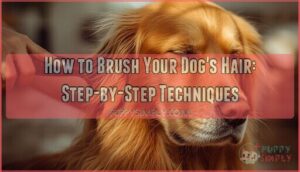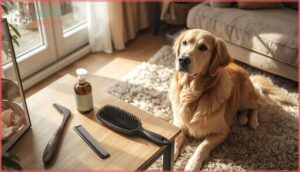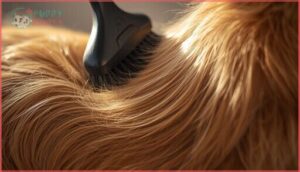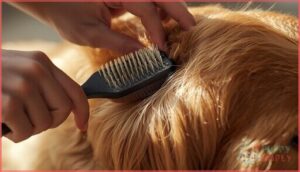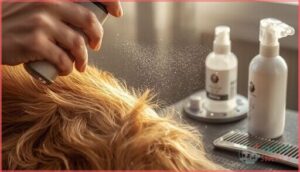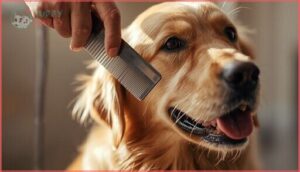This site is supported by our readers. We may earn a commission, at no cost to you, if you purchase through links.
Most people brush their dogs the same way they’d brush their own hair—quick strokes, minimal technique, done in five minutes. That approach misses what’s actually happening beneath the surface.
Proper dog hair brushing techniques do far more than keep your dog looking good. They prevent painful mats, catch early signs of infection or parasites, and build trust between you and your dog during grooming.
The right technique matched to your dog’s specific coat type transforms brushing from a chore into something that protects your dog’s health and strengthens your bond. Your dog’s coat tells a story about their wellbeing, and you’re the one with the brush in your hand.
Table Of Contents
- Key Takeaways
- Choosing The Right Brush for Your Dog
- Preparing Your Dog for Brushing
- Step-by-Step Brushing Techniques
- Brushing Frequency and Routine Care
- Preventing and Solving Common Brushing Problems
- Frequently Asked Questions (FAQs)
- How to properly brush your dog’s hair?
- Is it better to brush a dog’s hair wet or dry?
- In what order should you line brush a dog’s coat?
- Should I brush with or against my dogs fur?
- How often should I brush my dog?
- Can I brush my dogs hair when its wet?
- Whats the best brush for a puppy?
- What shampoo should I use?
- Can I shave my dogs fur?
- How long should each brushing session typically last?
- Conclusion
Key Takeaways
- Matching your brush type to your dog’s specific coat length and texture prevents painful mats and protects skin health better than using one generic tool for all dogs.
- Brushing with the direction of hair growth while using techniques like line brushing and pat-and-pull methods catches hidden tangles before they become serious problems.
- Your brushing frequency should match your dog’s coat type—short coats need weekly sessions while long and double coats require daily attention to stay healthy and mat-free.
- The areas behind your dog’s ears, under their collar, and between their limbs are friction hotspots where mats form fastest and need extra attention during every grooming session.
Choosing The Right Brush for Your Dog
The right brush makes all the difference for keeping your dog’s coat healthy and mat-free. Different coat types need different tools, and what works great for a fluffy Golden Retriever won’t do much for a short-haired Boxer.
Let’s look at which brushes work best for your dog’s specific coat.
Brushes for Short, Medium, and Long Coats
Coat length matters when choosing the right brush for your dog. Short-coated breeds like Boxers need bristle or rubber brushes with soft, dense bristles for weekly grooming. Medium-coated dogs, such as Golden Retrievers, benefit from pin brushes two to three times weekly. Long-coated breeds require long-pin brushes daily to prevent matting.
Pin length should match your dog’s coat depth: 20 mm for short coats, 27 mm for medium, and 35 mm for long coats. Dogs with double coats need undercoat rakes to reach dense inner layers and manage shedding effectively.
Regular cleaning helps maintain good brush condition.
When to Use Slicker, Pin, and Metal Combs
Now that you know which brush type matches your dog’s coat length, let’s talk about when to use each one. Slicker brushes excel at breaking up surface tangles and working through high-friction areas like behind the ears and under the collar. Pin brushes handle long, flowing sections better for everyday maintenance. Metal combs finish the job—use them after brushing to verify no tangles remain hidden.
A soft slicker brush is ideal for dogs with delicate skin. This dematting sequence keeps coat-specific brushing efficient and protects sensitive skin during grooming techniques.
Recommended Brands and Tools
Once you’ve matched brush type to coat, you’ll want tools that work hard and last. Shedding control is crucial, and the FURminator stands out for its effectiveness. The Hertzko slicker brush is another great option, known for being easy to clean and gentle on your dog’s coat. For show dogs, Chris Christensen pin brushes are highly recommended for their ability to create a shiny finish. Combo brushes are versatile, covering daily grooming needs with ease.
- FURminator effectiveness for shedding
- Hertzko slicker brush for detangling
- Chris Christensen pin brushes for finishing
- Combo brushes for all-in-one care
- Retail availability of top dog brushes
Most dog grooming tools are widely available at major retailers, making it convenient to find the perfect brush for your pet’s needs.
Preparing Your Dog for Brushing
Before you start brushing, you’ll want to set your dog up for success. Getting your dog ready involves a few key steps that make the whole process easier and more comfortable for them.
Let’s walk through what you need to do to prepare.
Creating a Calm Brushing Environment
Where your dog gets brushed matters just as much as how you brush. A quiet, comfortable room away from distractions helps your dog stay calm during grooming. Use sound enrichment like soft music or white noise to mask sudden noises. Consider pheromone diffusers to create a relaxing atmosphere. Consistent space design signals to your dog that brushing time is safe.
Gentle handling paired with positive reinforcement builds trust and makes the experience something your dog looks forward to rather than dreads.
Checking for Tangles, Mats, and Skin Issues
Before you start brushing, run your fingers through the fur, feeling for mats or tangles, especially behind ears and under limbs. Early Mat Detection helps you spot trouble before it gets painful.
Look for skin irritation, redness, or skin lesions—these can signal underlying skin conditions. Parasite Identification is easier on a dark surface.
For Safe Mat Removal, avoid scissors; clippers and Post-Removal Care keep skin healthy.
Introducing Brushing to Puppies and Nervous Dogs
Even if your pup’s tail is tucked, you can build trust with Early handling and Positive reinforcement. Use Desensitization protocols and Structured exercises to introduce dog brushes gently. Watch for changes in dog behavior and keep sessions brief. Here’s a simple brushing routine:
- Let them sniff the brush
- Touch fur lightly
- Give treats
- Pause often
- End on calm
Step-by-Step Brushing Techniques
Now that your dog is ready, it’s time to focus on the actual brushing. The right technique matters just as much as the right tool—it’s what keeps your dog comfortable and prevents damage to their coat.
In this section, you’ll learn the methods that work best for different situations.
Brushing in The Direction of Hair Growth
Your dog’s hair grows in a specific direction—from head toward tail and body toward limbs. Brushing with this coat growth pattern protects skin and reduces discomfort.
Why does this matter? Brushing against the grain can cause painful pulling and microtrauma to hair follicles.
When you follow the natural stroke orientation, you stimulate skin circulation, distribute natural oils evenly through conditioner application, and help prevent infections like furunculosis. Gentle, directional brushing techniques make grooming comfortable for your dog while keeping the coat healthy and shiny.
Brushing in the direction of hair growth stimulates circulation, distributes natural oils, and keeps your dog’s coat healthy and comfortable
The Pat and Pull and Line Brushing Methods
What if the mats forming deep at your dog’s skin could be prevented entirely? The pat and pull method combined with line brushing reaches where surface brushing can’t. Here’s how these techniques work together:
- Part the coat into small lines, exposing a strip at the skin
- Place your slicker brush flat and pat gently toward the skin
- Pull the brush outward at a shallow angle through the full hair length
- Comb through each line before moving to the next section
This systematic approach prevents hidden mats and keeps your dog comfortable.
Using Detangling Sprays for Mats
When mats dig deep into your dog’s coat, brushing alone won’t cut it. Detangling sprays contain conditioning agents that reduce friction between hairs, making mat separation easier and less painful for your dog. Spray affected areas until lightly damp, wait 2–3 minutes, then work through with a wide-tooth comb in small sections. This approach shortens dematting time while protecting your dog’s skin and coat health.
| Spray Ingredients | Application Methods |
|---|---|
| Silicones and fatty acids | Mist matted areas lightly |
| Quaternary ammonium compounds | Leave on 2–3 minutes |
| Conditioning agents | Massage gently with fingers |
| Moisture-boosting formulas | Use wide-tooth comb after |
Comb Checks for Tangle-Free Results
After brushing, run a fine-toothed comb through your dog’s coat to catch what the brush missed. This simple step reveals hidden tangles and lets you spot skin irritations, fleas, or dry patches early.
Daily comb checks for long-haired breeds prevent mat formation by removing trapped loose hairs that reduce shedding. Use wide teeth first, then fine teeth to confirm tangles are gone.
Pay special attention to friction-prone areas like ears and the collar line for effective mat prevention.
Brushing Frequency and Routine Care
Finding the right brushing schedule makes all the difference for your dog’s coat health. What works for one dog might not work for another because coat type, breed, and time of year all play a role.
Let’s look at how to build a routine that keeps your dog’s fur in top shape.
How Often to Brush Based on Coat Type
Your dog’s coat length matters more than you might think. Short-haired dogs need brushing once weekly, while medium coats benefit from two to three times per week. Long-haired breeds require daily brushing to prevent painful mats. Double-coated dogs like Huskies need two to three times weekly under normal conditions. Curly and wavy coats demand brushing every two to three days.
These breed-specific needs keep your dog’s coat healthy and manageable year-round.
Adjusting Brushing During Shedding Seasons
Spring and fall bring heavy shedding peaks for double-coated breeds like German Shepherds and Labs. During these coat blows, bump your brushing frequency to daily or nearly daily to manage the undercoat release.
You’ll want to add deshedding tools and metal combs to your routine, working section by section through high-shed areas like the thighs and rump. This targeted approach controls loose hair and prevents matting without damaging skin.
Brushing Before and After Bathing
Before you bathe your dog, pre-bath detangling removes loose hair and prevents mats from tightening when wet. Work through problem areas like behind the ears and under the collar with a slicker brush or comb.
After bathing, brush your dog’s coat during blow-drying to separate strands and speed moisture removal. Once fully dry, a final brushing redistributes natural oils, exposes the skin for health checks, and breaks up early tangles before they compact.
Preventing and Solving Common Brushing Problems
Even with the best technique, brushing challenges come up. You’ll want to know how to handle mats safely and keep your dog’s skin healthy while grooming.
Here’s what you need to watch out for and how to fix common problems.
Identifying and Removing Mats Safely
Mats form when dead hair and debris trap together, creating dense tangles that can restrict movement and trap moisture. Long-haired breeds like Poodles and Golden Retrievers are especially prone to matting.
Start removal by holding the mat base near the skin to prevent discomfort. Use a slicker brush or dematting rake, working from bottom to top. For stubborn mats, apply detangling spray first to soften the fur. Always prioritize safe removal techniques over speed.
Preventing Over-Brushing and Skin Irritation
Brushing too often strips the natural oils your dog needs, leaving skin dry and irritated. Watch for redness or flaking after sessions.
Short-haired dogs need just weekly brushing, while long-haired breeds do best with daily attention. Use grooming sprays to reduce friction and protect the coat. Softer bristles work gentler on sensitive skin.
Give your dog rest days between sessions so natural oils can restore. This balance keeps skin healthy and comfortable.
Focus Areas Prone to Matting (Ears, Limbs, Collar)
Behind your dog’s ears, under the collar, and between the limbs, friction creates the perfect storm for matting. Moisture trapped in these areas compounds the problem.
Daily brushing with gentle strokes prevents early tangles from becoming dense mats. Pay special attention to these hotspots during every session.
If mats are already tight to skin, skip aggressive brushing and see a professional groomer to avoid injury and skin damage.
Making Brushing a Positive Experience
Turning brushing into something your dog actually looks forward to takes patience and the right approach. Reduce grooming stress by starting with short sessions in quiet spaces, then gradually introduce tools paired with treats. Build positive reinforcement through consistent routines so your dog knows what’s coming. Use desensitization methods for nervous dogs, beginning with gentle touches in low-sensitivity areas. Environmental factors matter—keep things calm and predictable. Your handling techniques set the tone for every session.
- Start with brief 5-minute sessions in distraction-free environments
- Pair every brush contact with high-value treats or praise
- Use desensitization by introducing tools gradually before touching skin
- Establish a consistent daily or weekly brushing schedule
- Watch for stress signals like lip licking and pause when needed
Frequently Asked Questions (FAQs)
How to properly brush your dog’s hair?
Start by choosing the right brush for your dog’s coat type. Short coats need rubber brushes, while long coats benefit from slicker or pin brushes.
Use gentle pressure, brush with hair growth, and watch for your dog’s comfort signals throughout grooming sessions.
Is it better to brush a dog’s hair wet or dry?
Most dogs do best with dry or slightly damp coats. Wet hair stretches and breaks easily under brush tension.
Use detangling sprays on dry coats to reduce friction. Long-haired breeds especially need pre-bath brushing to prevent mats from tightening when wet.
In what order should you line brush a dog’s coat?
Think of line brushing like painting a wall—you work from bottom to top in small sections. Start at your dog’s legs or tail, then move upward toward the head, brushing each layer completely before advancing.
Should I brush with or against my dogs fur?
You should brush with the grain for most grooming routines.
Brushing against your dog’s coat can lift undercoat during heavy shedding, but always finish by smoothing hair back in the natural direction.
How often should I brush my dog?
Your dog’s coat tells you how often to brush. Short-haired breeds need weekly sessions, while long or double coats require daily attention.
During spring and fall shedding peaks, increase your brushing frequency for every dog.
Can I brush my dogs hair when its wet?
You shouldn’t brush your dog’s hair when it’s fully wet because wet hair breaks more easily. Towel-dry first, then brush once the coat is completely dry to avoid tangling and damage.
Whats the best brush for a puppy?
Your puppy’s coat type determines the safest brush. Soft bristle brushes work well for short-haired puppies, while rubber curry combs gently massage skin and lift loose hair without scratching delicate puppy skin during grooming.
What shampoo should I use?
Choose shampoos formulated specifically for dog grooming with a proper pH balance around 0 to Match the formula to your dog’s coat type and skin condition, avoiding harsh ingredients while considering bathing frequency for best dog skin care.
Can I shave my dogs fur?
While clipping seems harmless, it disrupts coat thermal regulation and can cause sunburn and shaving-related alopecia after shaving. Skin barrier loss increases irritation.
Shaving considerations for dog grooming require veterinary guidance for specific dog breeds.
How long should each brushing session typically last?
Most brushing sessions last 10–15 minutes for routine maintenance. Short-coated breeds need only 5–10 minutes, while long or thick coats require 20–30 minutes. Heavy matting extends sessions beyond 30 minutes considerably.
Conclusion
A single missed mat can spiral into a skin infection that costs hundreds in vet bills. Proper dog hair brushing techniques aren’t about flawlessness—they’re about consistency and attention.
Your dog depends on you to notice what they can’t communicate. The brush in your hand is more than a grooming tool. It’s your daily health check and your quiet conversation.
Show up for those sessions. Your dog’s comfort and wellbeing live in that routine.
- https://www.rspcapetinsurance.org.au/pet-care/dog-care/when-to-groom-your-dog
- https://www.rover.com/blog/how-to-brush-dog/
- https://vetmed.tamu.edu/news/pet-talk/reduce-dog-shedding/
- https://www.bosspetedge.com/blog/5-benefits-of-brushing-your-dog/
- https://www.thepawspasalon.com/post/how-to-prevent-and-treat-matting-in-long-haired-dogs

